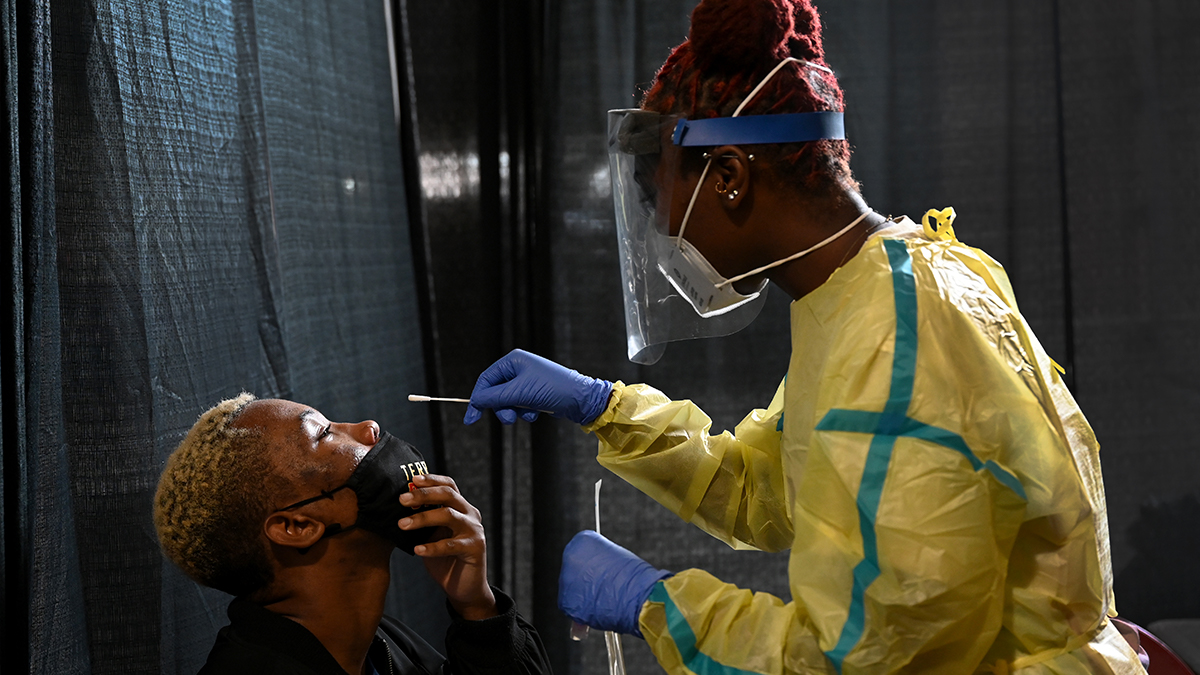As Virginia imposes new restrictions in parts of the state, hospitalizations of coronavirus patients continue to rise.
Dr. Deborah Birx, the White House's Coronavirus Response Coordinator, told Gov. Ralph Northam Tuesday that residents should wear masks and indoor dining should be restricted. She also advised limiting the size of social gatherings and shutting down bar areas to reduce the spread of the virus in Virginia.
Following their meeting, Northam reinstated some restrictions in the Hampton Roads area, which has been hit hard by the coronavirus. The current restrictions in Northern Virginia will remain, but the governor said officials will let the virus data guide them.
In Virginia, the spread of the COVID-19 continues to grow rapidly outside of the Greater Northern Virginia region. Greater Northern Virginia has an average of 254 daily new cases, while the rest of the state is averaging 831 daily new cases.
On Wednesday, D.C. officials announced they raised one benchmark for when the city will be ready to move into reopening phase three. Officials previously said they wanted to see a sustained positivity rate of 10% or below. That standard has been moved to 5% or below as of Wednesday, Health Director LaQuandra Nesbitt said.
FAQ: What to Know About DC's Order to Self-Quarantine After Travel to Virus Hot Spots
What the Data Shows
Case numbers didn't top any recent records on Wednesday, with D.C. adding 54 new cases, Maryland adding 761 and Virginia adding 968.
In D.C., 11,999 residents have been diagnosed with coronavirus. Of those diagnosed, 9,723 have recovered and have been cleared from isolation.
Hospitalizations are up in Maryland and Virginia. Hospitals are treating 866 coronavirus patients in Virginia, 571 in Maryland and 83 in D.C.
In Virginia, Wednesday's hospitalization count is higher than it's been since June 3.
Coronavirus deaths climbed by 29 in Virginia, 20 in Maryland and by one in D.C.
More than 2 million coronavirus tests have been administered in D.C., Maryland and Virginia.
The map below shows the number of coronavirus cases diagnosed per 1,000 residents.
Coronavirus Cases in DC, Maryland and Virginia
COVID-19 cases by population in D.C. and by county in Maryland and Virginia
Source: DC, MD and VA Health Departments
Credit: Anisa Holmes / NBC Washington
Local Coronavirus Headlines
- A quick trip to nearby beach towns could require you to quarantine for two weeks once you return to D.C. This could have a significant economic impact on popular beaches. Watch the report.
- There is a push for Fauquier County schools to nix the district's plan to offer some in-person classes. Read more.
- D.C. will require residents and visitors entering the city from 27 states to self-quarantine for two weeks. Read more.
- The National Zoo reopened Friday, allowing a limited number of daily visitors while implementing new safety measures such as mandatory face masks. Watch the report.
- Amid growing concerns about a surge in coronavirus cases this month, a group of nurses gathered outside of Washington MedStar Hospital to voice concerns about their safety on the job. Watch the report.
- D.C. implemented strict new mask guidelines, saying face coverings must be worn whenever you leave home, with few exceptions. Read more.
- D.C. will empower inspectors to issue on-the-spot citations to businesses that violate social distancing rules.
- Fairfax County Public Schools has shifted to a 100% online start to the school year, citing health data. Read more.
Reopening Tracker
- Virginia entered phase three reopening on July 1, loosening restrictions on restaurants, stores, gyms and pools. Northam said more restrictions could be implemented if cases continue to grow.
- Prince George's County entered full phase two on June 23, allowing the MGM Casino and gyms to reopen.
- D.C., entered phase two on June 22, allowing indoor dining, gyms, libraries and houses of worship to reopen with restrictions.
- Montgomery County entered phase two on June 19, reopening with restrictions gyms, houses of worship, indoor dining and retail.
- Maryland entered phase two of reopening on June 10, permitting indoor dining, outdoor pools and outside amusements to reopen.
How to Stay Safe
There are ways to lower your risk of catching coronavirus. Here are guidelines from the CDC:
- Wear a snug-fitting mask that covers your nose and mouth.
- Avoid being indoors with people who are not members of your household. The more people you are in contact with, the more likely you are to be exposed to COVID-19. If you are indoors with people you don’t live with, stay at least six feet apart and keep your mask on.
- Wash your hands often, especially after you have been in a public place.
Sophia Barnes, Andrea Swalec and Anisa Holmes contributed to this report



